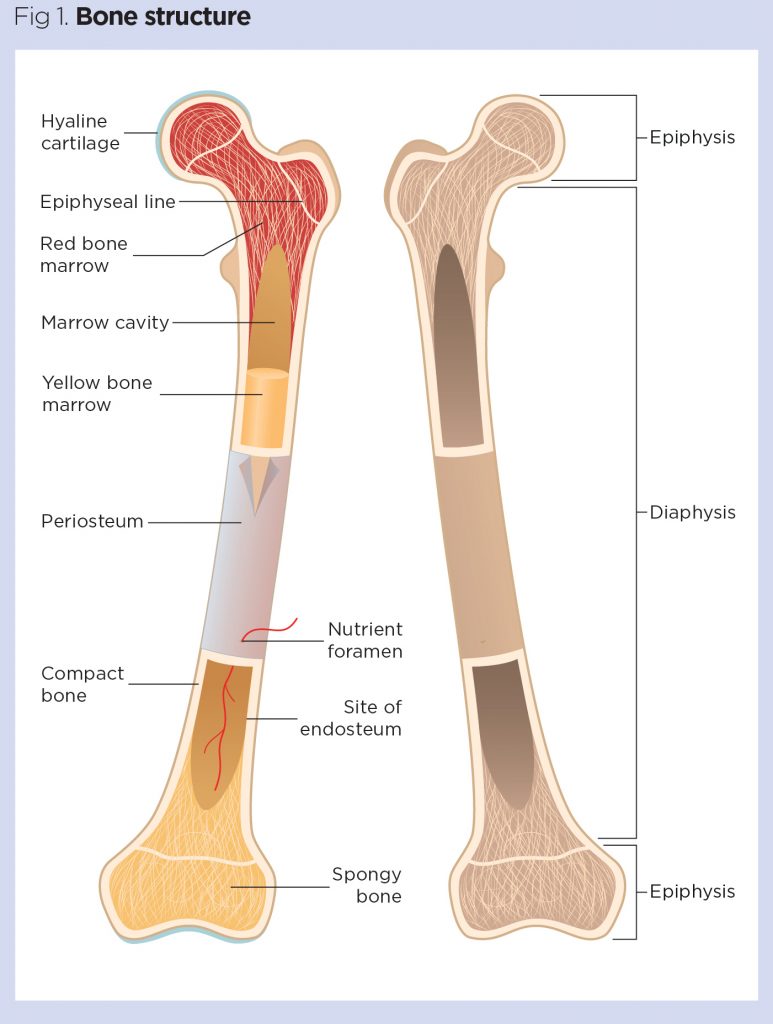
Lesson 5 Osteology
The primitive embryonal skeleton consists of cartilage and fibrous tissue, in which the bones develop. The process is termed ossification or osteogenesis, and is effected essentially by bone-producing cells, called osteoblasts. It is customary, therefore, to designate as membrane bones those which are developed in fibrous tissue, and as cartilage bones those which are preformed in cartilage. The principal membrane bones are those of the roof and sides of the cranium and most of the bones of the face. The cartilage bones comprise, therefore, most of the skeleton. Correspondingly we distinguish intramembranous and endochondral ossification. In intramembranous ossification the process begins at a definite center of ossification (Punctum ossificationis) , where the osteoblasts surround themselves with a deposit of bone. The process extends from this center to the periphery of the future bone, thus producing a network of bony trabeculae. The trabeculae rapidly thicken and coalesce, forming a bony plate which is separated from the adjacent bones by persistent fibrous tissue. The superficial part of the original tissue becomes periosteum, and on the deep face of this successive layers of periosteal bone are formed by osteoblasts until the bone attains its definitive thickness. Increase in circumference takes place by ossification of the surrounding fibrous tissue, which continues to grow until the bone has reached its definitive size. In endochondral ossification the process is fundamentally the same, but not quite so simple. Osteoblasts emigrate from the deep face of the perichondrium or primitive periosteum into the cartilage and cause calcification of the matrix or ground substance of the latter. Vessels extend into the calcifying area; the cartilage cells shrink and disappear, forming primary marrow cavities, which are occupied by processes of the osteogenic tissue. There is thus formed a sort of scaffolding of calcareous trabeculae on which the bone is constructed by the osteoblasts. At the same time perichondria bone is formed by the osteoblasts of the primitive periosteum. The calcified cartilage is broken down and absorbed through the agency of large cells called osteoclasts, and is replaced by bone deposited by the osteoblasts. The osteoclasts also cause absorption of the primitive bone, producing the marrow cavities; thus in the case of the long bones the primitive central spongy bone is largely absorbed to form the medullary cavity of the shaft, and persists chiefly in the extremities. Destruction of the central part and formation of subperiosteal bone continue until the shaft of the bone has completed its growth.
CHEMICAL COMPOSITION OF BONE
Dried bone consists of organic and inorganic matter in the ratio of 1 : 2 approximately. The animal matter gives toughness and elasticity, the mineral matter hardness, to the bone tissue. Removal of the organic matter by heat does not change the general form of a bone, but reduces the weight by about one-third, and makes it very fragile. Conversely, decalcification, while not affecting the form and size of the bone, renders it soft and pliable. The organic matter (ossein) when boiled yields gelatin. The following table represents the composition in 100 parts of ox bone of average quality:
Gelatin 33.30
Phosphate of Ume 57.35
Carbonate of lime 3.85
Phosphate of magnesia 2.05
Carbonate and chlorid of sodium 3.45
_________________
100.00
PHYSICAL PROPERTIES OF BONE
Fresh dead bone has a yellowish-white color; when macerated or boiled and bleached, it is white. The specific gravity of fresh compact bone is a little over 1.93. It is very hard and resistant to pressure; a 5-millimeter cube of compact bone of the ox will resist pressure up to 852 pounds, if the pressure be applied in the line of the lamellae (Rauber). Its tensile strength is estimated to be nearly twice that of oak.
DESCRIPTIVE TERMS
The surfaces of the bones present a great variety of eminences and depressions, as well as perforations. The prominences and cavities may be articular, or nonarticular, furnishing attachment to muscles, tendons, ligaments, or fascia. A number of descriptive terms are used to designate these features, and the following are some of those in general use:
Process (Processus) is a general term for a prominence.
A tuberosity (Tuber, Tuberositas) is a large, rounded projection; a tubercle (Tuberculum) is a smaller one.
The term trochanter is applied to a few prominences, e.g., the trochanters of the femur.
A spine (Spina) or spinous process (Processus spinosus) is a pointed projection.
A crest (Crista) is a sharp ridge.
A line (Linea) is a very small ridge.
A head (Caput) is a rounded articular enlargement at the end of a bone; it may be joined to the shaft by a constricted part, the neck (Collum).
A condyle (Condylus) is an articular eminence, which is cylindrical; a non-articular projection in connection with a condyle may be termed an epicondyle (Epicondylus).
A trochlea is a pulley-like articular mass.
A glenoid cavity (Cavitas glenoidalis) is a shallow articular depression, and a cotyloid cavity or acetabulum is a deeper one.
The term facet is commonly applied to articular surfaces of small extent, especially when they are not strongly concave or convex.
The terms fossa, fovea, groove or sulcus, and impression are applied to various forms of depressions.
A foramen is a perforation for the transmission of vessels, nerves, etc.
A sinus is an air-cavity within a bone or bones; it is lined with mucous membrane and communicates with the exterior.
Other terms, such as canal, fissure, notch, etc., require no explanation.


